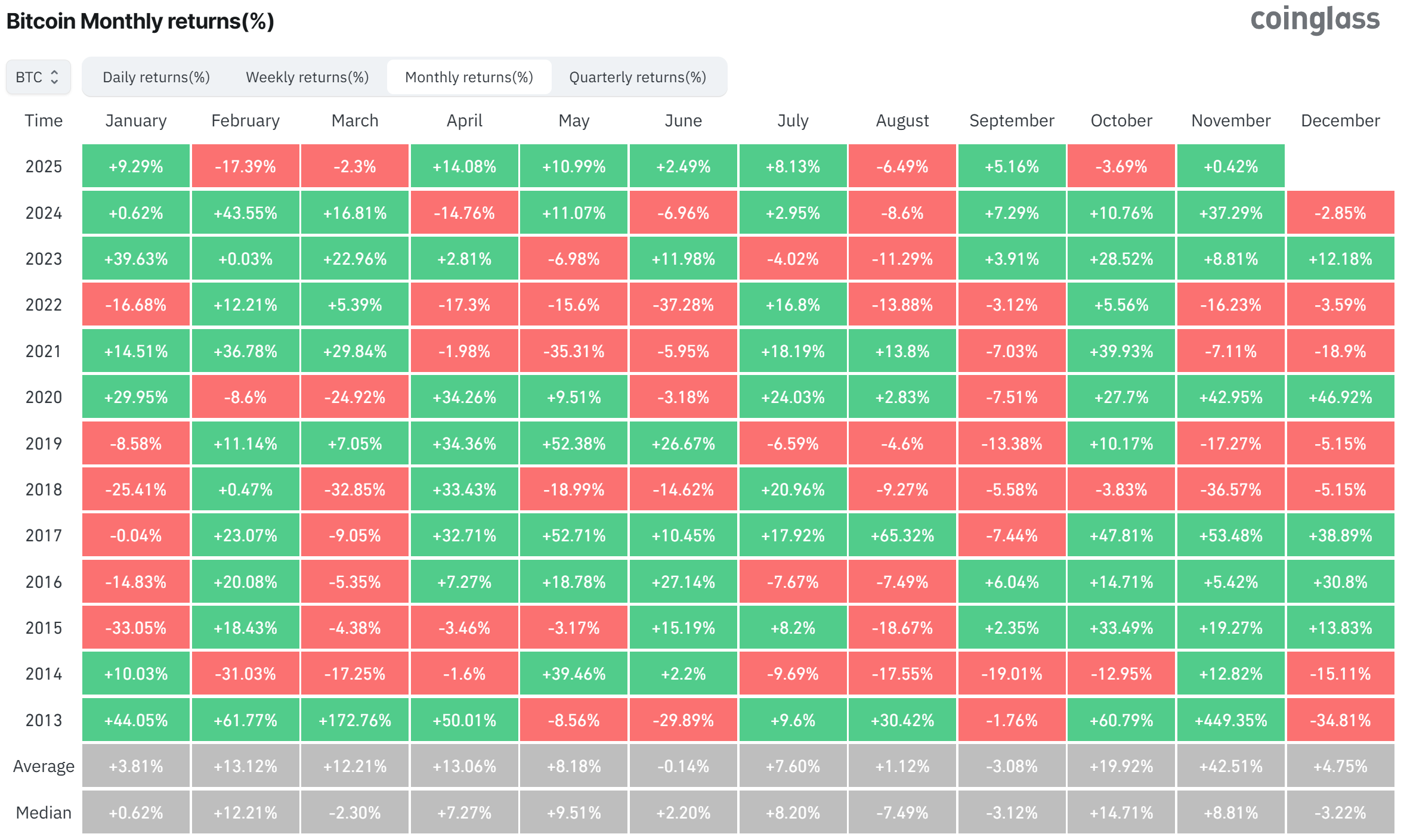Bitcoin has historically delivered its strongest monthly gains in November, averaging 42.51% since 2013, potentially pushing the price above $160,000 this year amid favorable macroeconomic conditions like Federal Reserve rate cuts and easing U.S.-China trade tensions.
-
Historical Performance: Bitcoin’s November gains average 42.51% since 2013, marking the peak month for price appreciation in the cryptocurrency’s cycle.
-
Macro Tailwinds: Expected U.S. Federal Reserve interest rate reductions and progress in U.S.-China trade negotiations could further support Bitcoin’s upward momentum.
-
Economic Uncertainties: Ongoing U.S. government shutdown and tariff threats pose risks, with recent market liquidations totaling $19 billion highlighting volatility.
Explore Bitcoin’s potential November 2025 rally with 42.51% historical gains amid Fed rate cuts and trade deals. Key insights on macro factors driving crypto growth—read now for informed investing.
What Drives Bitcoin’s November 2025 Rally?
Bitcoin’s November 2025 rally is fueled by a combination of historical seasonality and supportive macroeconomic developments. Since 2013, November has consistently been Bitcoin’s strongest month, with an average price increase of 42.51%, often setting the stage for year-end surges. Analysts project that if this pattern holds, Bitcoin could exceed $160,000, bolstered by anticipated Federal Reserve actions and geopolitical progress that reduce economic pressures.
How Do U.S.-China Trade Developments Impact Bitcoin Prices?
Recent discussions between U.S. President Donald Trump and Chinese President Xi Jinping represent a potential thaw in longstanding trade tensions, which could positively influence Bitcoin prices. The meeting, described by Trump as “amazing,” included agreements to reduce U.S. tariffs in return for China’s commitments on fentanyl control, soybean purchases, and easing restrictions on rare earth exports for one year. Such steps may stabilize global markets, encouraging investment in risk assets like Bitcoin.

Bitcoin monthly returns since 2013. Source: CoinGlass
Trump expressed optimism for a swift trade deal, which contrasts with earlier tariff threats that triggered a sharp crypto market downturn, including $19 billion in liquidations within 24 hours on October 11. While Georgetown University professor Dennis Wilder views this as a temporary “pause” rather than a resolution, the development underscores how reduced trade friction can alleviate uncertainty and draw capital toward cryptocurrencies. Historical data shows that positive trade news often correlates with Bitcoin price recoveries, as investors shift from safe-haven assets to growth-oriented ones like digital currencies.
Frequently Asked Questions
What Role Do Federal Reserve Rate Cuts Play in Bitcoin’s November Performance?
Federal Reserve rate cuts lower borrowing costs, making riskier assets like Bitcoin more attractive to investors seeking higher returns. In early November 2025, the Fed implemented a quarter-point reduction, bringing rates to a three-year low, with markets pricing a 63% chance of another cut in December. This environment historically boosts Bitcoin, as seen in past cycles where monetary easing preceded significant rallies averaging over 40% in November.
Will the U.S. Government Shutdown Affect Crypto Market Approvals?
The ongoing U.S. government shutdown, now nearing its fifth week and potentially the longest in history, creates delays in regulatory processes. It hinders the Securities and Exchange Commission’s ability to approve pending crypto exchange-traded funds and advance bills like the CLARITY Act for clearer market structures. Resolution is crucial for regulatory clarity, which could accelerate institutional adoption and support Bitcoin’s momentum in a voice-searched context of economic stability.
The Federal Reserve’s recent quarter-point rate cut has set the stage for continued monetary easing, with the next policy meeting scheduled for December 10, 2025. Chair Jerome Powell noted that further adjustments are not guaranteed, yet traders anticipate relief. Lower rates typically encourage investment in high-yield assets, benefiting Bitcoin by increasing liquidity in the crypto space.
Additionally, the Fed’s decision to end its quantitative tightening program on December 1 marks a shift from balance sheet contraction to potential expansion through quantitative easing. Quantitative tightening aims to curb inflation by reducing money supply, but its halt injects optimism into markets, as more funds could flow into alternatives like cryptocurrencies. Arthur Hayes, a prominent industry voice, has highlighted how such policy pivots often precede bull runs in Bitcoin.

Source: Arthur Hayes
Quantitative easing, by contrast, floods the economy with liquidity, historically correlating with Bitcoin price appreciation as investors diversify into non-traditional holdings. Crypto analyst Markus Thielen of 10x Research emphasizes that while seasonal trends like November’s strength are influential, they must align with broader factors such as these Fed moves for sustained gains.
The U.S. government shutdown exacerbates economic uncertainty, with partisan disagreements stalling a spending plan. President Trump has urged Republicans to eliminate the Senate filibuster rule to break the impasse, posting on Truth Social about initiating a “nuclear option” to restore functionality. This prolonged disruption not only affects daily governance but also regulatory timelines critical for the crypto sector.
Bitcoin’s four-year cycle remains a key framework for understanding downturns, with venture capitalists forecasting potential 70% drops in future corrections, yet November’s seasonality often counters such risks. Broader market signals, including those analyzed by industry observers, suggest resilience if macro conditions improve. Hodler’s Digest from mid-October underscores rare top signals, with projections reaching $1 million in optimistic scenarios tied to policy support.
Key Takeaways
- Seasonal Strength: November’s 42.51% average gain since 2013 positions Bitcoin for potential highs above $160,000 in 2025, driven by historical patterns.
- Monetary Policy Boost: Fed rate cuts and the end of quantitative tightening enhance liquidity, historically favoring cryptocurrencies as investors seek yield.
- Geopolitical Watch: Monitor U.S.-China trade progress and shutdown resolution for reduced volatility, enabling clearer paths to regulatory approvals in crypto.
Conclusion
As Bitcoin enters November 2025, its historical November gains intersect with pivotal macroeconomic factors like Federal Reserve easing and U.S.-China trade advancements, potentially propelling prices toward new peaks. While uncertainties from the government shutdown persist, these elements collectively foster a bullish outlook for the cryptocurrency market. Investors should stay vigilant on policy updates to capitalize on emerging opportunities in this dynamic space.
